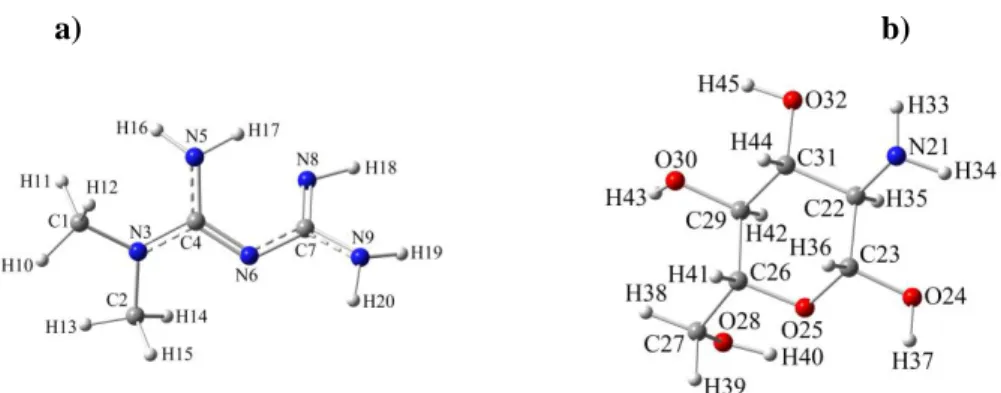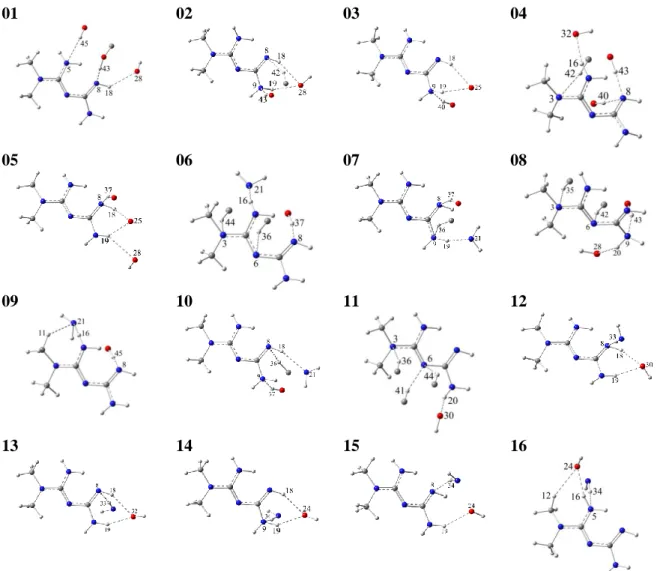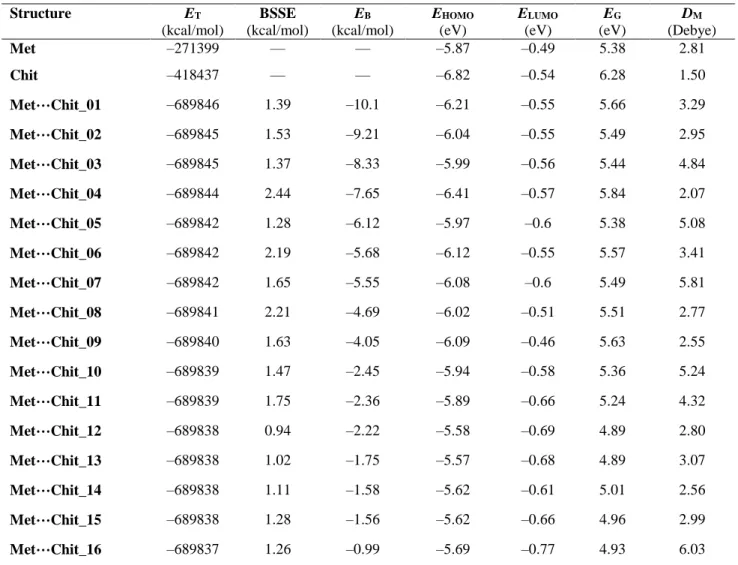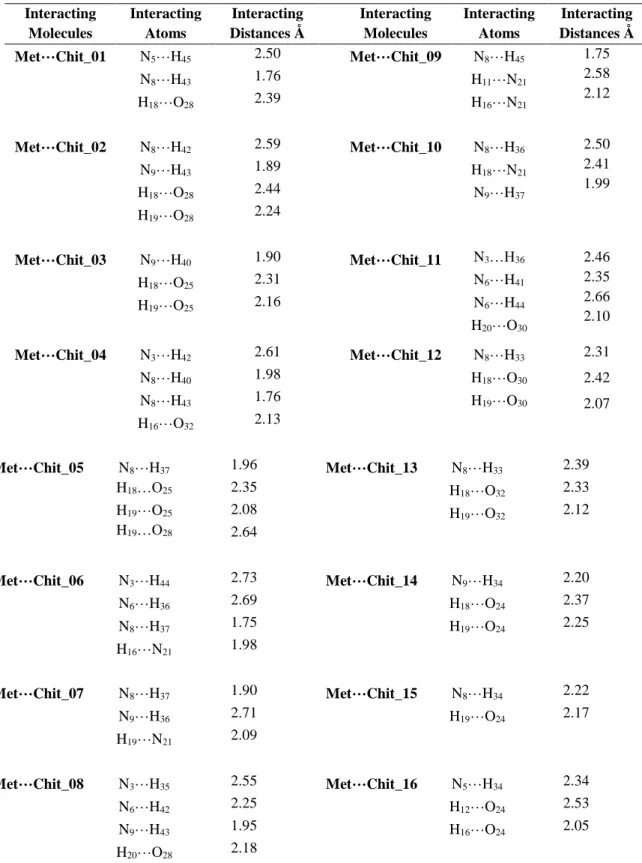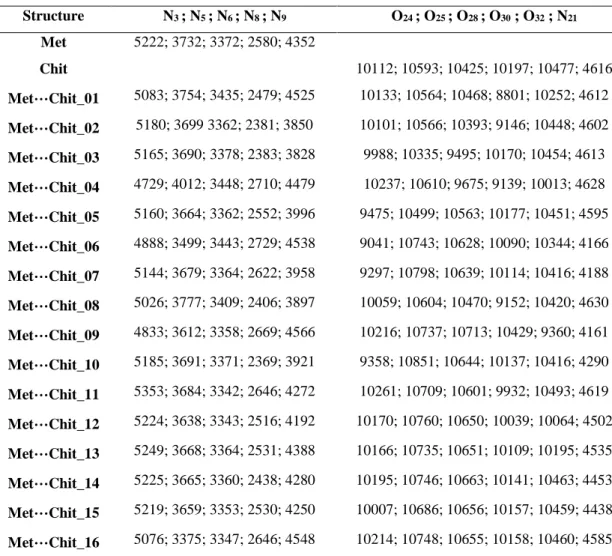*Corresponding author: Mahmoud Mirzaei
Tel: +98 (31) 37927101, Fax: +98 (31) 36680011 Iran. Chem. Commun. 7 (2019) 380-389 E-mail: mdmirzaei@pharm.mui.ac.ir
Page | 380
Payame Noor University http://icc.journals.pnu.ac.ir
ICC
Iranian Chemical Communication
A computational molecular approach on chitosan vehicle for
metformin
Mahmoud Mirzaeia,*, Oğuz Gülserenb, Elham Jafaria, Mehdi Aramideha
aDeaprtment of Medicinal Chemistry, School of Pharmacy and Pharmaceutical Sciences,
Isfahan University of Medical Sciences, Isfahan, Iran
bDepartment of Physics, Bilkent University, Ankara, Turkey
Received: 13 December 2018, Accepted: 15 February 2019, Published: 1 July 2019
Abstract
Density functional theory (DFT) calculations have been performed to study properties of chitosan (Chit) as a possible vehicle for carrying metformin (Met) drug. To this aim, the singular molecules of Met and Chit have been first optimized and, then, sixteen possible bimolecular complexes have been subsequently constructed and optimized to obtaine the stabilized interacting structures. Two bimolecular complexs have been seen as the most powerful interacting systems among all complexes. N5
and N8 atoms of Met are very important atoms for interacting with Chit counterpart.
Molecular parameters such as molecular orbital energies and dipole moments approved the effects of interations on both Chit and Met counterparts. Atomic scale quadrupole coupling constants demonstrated the effects of interactions on the electronic atomic sites. As a final remark, although the Chit could be used as a vehicle for Met; further investigations are still required to see what’s happening inside the molecular systems.
Keywords: Chitosan; metformin; density functional theory; molecular vehicle. Introduction
Metformin (Met) is a medicine for those people who are diagnosed with diabetes type–2 to control their sugar level in blood [1]. Although Met has been introduced as one of the most efficient anti–diabetes; low bioavailability and small absorption yield to high dosage administration for patients have been witnessed [2]. Therefore, hybridization with other biocompatible materials or carriers may increase the efficacy of Met with lower dosage administrations with higher bioavailability [3]. Earlier works have introduced chitosan (Chit) as a proper
vehicle to carry Met inside the body; however, further investigations are still required to achieve the purpose [4]. Chit is initially a biocompatible structure consisting of biological familiar glucose amine constructing monomers, which could be proposed as a good choice for applications in living systems [5]. Despite several experimental and theoretical achievements on Chit–Met hybrid systems; there is still a lack of information on molecular-scale details of interactions between Chit and Met molecules [6]. In an earlier work [7], the advantage of Chit as a gene carrier
Page | 381 has been very well investigated at the
molecular scale based on examining the intermolecular interactions. The intermolecular interactions e.g. hydrogen bonds, are dominant factors to maintain the stability of hybrid structures and also to predict their corresponding activities [8–12]. Therefore, molecular–scale studies could reveal important information about the nature of interacting systems [13]. Among the methodologies, computer–assisted investigations could generate information with high accuracy for the considered systems [14-23]. It is worth to note that the structure is very much important for the desired activity of a chemical compound or medicine; known as SAR [24].
This work has been established to investigate the characteristic properties of Chit as a vehicle for Met by careful examination of their intermolecular
interactions employing density functional theory (DFT) approach. Although several computational approaches have been established from molecular mechanics to high-level quantum mechanics in order to investigate molecular systems, DFT could be considered as a helpful approach to solve problems in the computational molecular scales [9,25,26]. Each singular structure of Met and Chit has been separately optimized and possible bimolecular complexes have been subsequently optimized and characterized to evaluate the interacting positions between two hetero molecular counterparts (Figures 1 and 2). Molecular and atomic scale electronic properties have been evaluated in addition to structural properties to see the details of Chit vehicle for carrying Met counterpart (Tables 1–3).
a) b)
Figure 1. The singular structures of a) Met (C4H11N5) and b) Chit (C6H13NO5)
Computational details
The B3LYP exchange-correlation functional [27] and the 6–311++G** standard basis set [28] have been employed as DFT approach of all calculations of this work. It is worth to note that the varaities of computational approaches always make a difficult task to choose the best method for calculations. In this case, earlier works indicated that our employed method
could generate reliable results for such systesm [25,26,29]; therefore, we have chosen the method for our work. Furthermore, our work has been done in the gas-phase system to show the original properties of Chit and Met structures avoiding the effects of solvents or any other media [9,29]. It is important to note that the Chit is originally a polymer structure; however, we employed glucosamine
Page | 382 molecule as the monomer of Chit in our
molecular-scale computations in accordance to the earlier works [7,30,31]. First, each of the singular Met and Chit structures and their possible interacting bimolecular complexes have been optimized to obtain the minium energy geometeris (Figures 1 and 2). Subsequently, the global minimum optimized structures have been also examined by the frequency calculations at the same level of theory. The Grimme dispersion correction has been included in all of the optimization calculations by adding IOp=(3/124=3) to the calculation route [32]. Furthermore, the basis set superposition errors (BSSE) have been examined for the bimolecular complexes by adding Counterpoise=2 to the calculation route [33]. As a result, minimized energy structures and their corresponding properties have been evaluated for the molecular counterparts of singular and complex structures. Table 1 demonstrates the values of total energies (ET), BBSE,
binding energies (EB) (eq. 1), energies
of the highest occupied and the lowest unoccupied molecular orbitals (EHOMO
and ELUMO), energy gaps (EG) (eq. 2),
and dipole moments (DM) for the
investigated molecular systems.
EB = EComplex – EMet – EChit (1)
EG = ELUMO – EHOMO (2)
Table 2 exhibits the interaction information including the interacting atoms and distances for the Met…Chit complexes. By the designed intermolecular geometries, sixteen
bimolecular complexes have been constructed to cover all the possible interactions for the Met and Chit counterparts. The interacting atoms of Chit with Met molecule are shown in Figure 2 for all sixteen models. Furthermore, the atomic-scale quadrupole coupling constants (CQ)
have been evaluated (eq. 3) (Table 3) by the electric field gradient (EFG) calculations of the nitrogen and oxygen atoms of the optimized structures. CQ = e2Qqzzh–1 (3)
The components of eq. 3 are e: electronic charge, Q: the nuclear quadruple moment, qzz: the EFG
eigenvalue, and h: the Planck’s constant [34–36]. All calculations of this work have been performed employing the Gaussian 09 package of program [37].
Results and discussion
Within this work, the capability of Chit vehicle for carrying Met drug has been examined based on DFT calculated results for singular and interacting bimolecular complex systems. All possible interacting positions have been first designed for the optimization processes to find the best intermolecular geometries and the corresponding properties for the Met…Chit bimolecular complexes. In addition to the interacting positions for molecular counterparts, their corresponding atomic scale CQ
properties have been also evaluated for the investigated models (Tables 1–3 and Figures 1 and 2).
Page | 383
01 02 03 04
05 06 07 08
09 10 11 12
13 14 15 16
Figure 2. Met…Chit bimolecular complexes; the Met structure and the interacting atoms of Chit are shown
to ease.
The results of Table 1 present the evaluated molecular properties for both of singular and complex optimized structures (Figs. 1 and 2). Based on the obtained ET values, the bimolecular
complex structures could be distinguished regarding their stabilities and the corresponding EB values. As a
result, the bimolecular complexes have been ranked by these values in this work; rank 01 represents the best
interacting situation among all possibilities. Small values of BSSE have been obtained for the ET and EB
parameters, in which they could be neglected for consideration in energy temrs. Careful examinations of EB
values could indicate that the intermolecular geometries of bimolecular complexes are very much important to achieve a strong interacting complex.
Page | 384
Table 1. Molecular properties for Met and Chit in singular and complex structures*
Structure ET (kcal/mol) BSSE (kcal/mol) EB (kcal/mol) EHOMO (eV) ELUMO (eV) EG (eV) DM (Debye) Met –271399 — — –5.87 –0.49 5.38 2.81 Chit –418437 — — –6.82 –0.54 6.28 1.50 Met…Chit_01 –689846 1.39 –10.1 –6.21 –0.55 5.66 3.29 Met…Chit_02 –689845 1.53 –9.21 –6.04 –0.55 5.49 2.95 Met…Chit_03 –689845 1.37 –8.33 –5.99 –0.56 5.44 4.84 Met…Chit_04 –689844 2.44 –7.65 –6.41 –0.57 5.84 2.07 Met…Chit_05 –689842 1.28 –6.12 –5.97 –0.6 5.38 5.08 Met…Chit_06 –689842 2.19 –5.68 –6.12 –0.55 5.57 3.41 Met…Chit_07 –689842 1.65 –5.55 –6.08 –0.6 5.49 5.81 Met…Chit_08 –689841 2.21 –4.69 –6.02 –0.51 5.51 2.77 Met…Chit_09 –689840 1.63 –4.05 –6.09 –0.46 5.63 2.55 Met…Chit_10 –689839 1.47 –2.45 –5.94 –0.58 5.36 5.24 Met…Chit_11 –689839 1.75 –2.36 –5.89 –0.66 5.24 4.32 Met…Chit_12 –689838 0.94 –2.22 –5.58 –0.69 4.89 2.80 Met…Chit_13 –689838 1.02 –1.75 –5.57 –0.68 4.89 3.07 Met…Chit_14 –689838 1.11 –1.58 –5.62 –0.61 5.01 2.56 Met…Chit_15 –689838 1.28 –1.56 –5.62 –0.66 4.96 2.99 Met…Chit_16 –689837 1.26 –0.99 –5.69 –0.77 4.93 6.03
* See Figures 1-3 for the model structures.
The information of Table 2 and Figure 2 show that the atoms N5 and N8
of Met are very much important atomic sites for the formation of interactions with H45 and H43 of Chit to make strong
interacting complexes. None of other bimolecular complexes have such situations as their interactions are weaker than the 01 complex. Up to
Met…Chit_16 bimolecular complex, the EB value reaches to –0.99 kcal/mol;
ten times weaker than 01 complex. This is an important task for the molecular level studies, in which the characteristic properties are very well recognized for the investigated molecular systems in the lowest possible molecular scale.
Page | 385
Table 2. Molecular interaction properties for Met…Chit complexes* Interacting Molecules Interacting Atoms Interacting Distances Å Interacting Molecules Interacting Atoms Interacting Distances Å Met…Chit_01 N5…H45 N8…H43 H18…O28 2.50 1.76 2.39 Met…Chit_09 N8…H45 H11…N21 H16…N21 1.75 2.58 2.12 Met…Chit_02 N8…H42 N9…H43 H18…O28 H19…O28 2.59 1.89 2.44 2.24 Met…Chit_10 N8…H36 H18…N21 N9…H37 2.50 2.41 1.99 Met…Chit_03 N9…H40 H18…O25 H19…O25 1.90 2.31 2.16 Met…Chit_11 N3…H36 N6…H41 N6…H44 H20…O30 2.46 2.35 2.66 2.10 Met…Chit_04 N3…H42 N8…H40 N8…H43 H16…O32 2.61 1.98 1.76 2.13 Met…Chit_12 N8…H33 H18…O30 H19…O30 2.31 2.42 2.07 Met…Chit_05 N8…H37 H18…O25 H19…O25 H19…O28 1.96 2.35 2.08 2.64 Met…Chit_13 N8…H33 H18…O32 H19…O32 2.39 2.33 2.12 Met…Chit_06 N3…H44 N6…H36 N8…H37 H16…N21 2.73 2.69 1.75 1.98 Met…Chit_14 N9…H34 H18…O24 H19…O24 2.20 2.37 2.25 Met…Chit_07 N8…H37 N9…H36 H19…N21 1.90 2.71 2.09 Met…Chit_15 N8…H34 H19…O24 2.22 2.17 Met…Chit_08 N3…H35 N6…H42 N9…H43 H20…O28 2.55 2.25 1.95 2.18 Met…Chit_16 N5…H34 H12…O24 H16…O24 2.34 2.53 2.05
* See Figures 1 and 2 for the atoms numbers and model structures. All possible interactions are considered for the
Page | 386 Based on the obtained
intermolecular EB values and
geometries, it could be concluded that the interaction is possible for Met and Chit bimolecular complexes; however, the strength quality of interacting systems could be measured by quantities of energies and distances showing the variations of integration situations.
As a concluding remark of this section, the Chit could be proposed as a carrier for Met, but it is better to protect other interacting atomic sites of Chit not to interact with Met counterpart.
Further examinations of contents of Table 1 could show the effects of molecular interactions on the HOMO and LUMO energies. Comparing the results of bimolecular complexes with those of singular Met and Chit could show the changes of molecular orbital energies in the bimolecular complexes, in which the effects on the HOMO levels are more significant in comparison to the LUMO levels. The corresponding EG values also approve
the obtained results by variations of values of different bimolecular complexes. The EG values are notable
for 01 complex in comparison to other complexes as that of the 16 complex has very small meaning and more reactivity but possesses less stability of the mentioned structure among other complexes as indicated before by the values of ET and EB. The DM values
also refer to the different electronic environments for the bimolecular complexes, in which the values are varied among the models. As a final conclusion of the results of Tables 1 and 2, it could be mentioned that the Chit structure could be seen as a vehicle for carrying Met drug; however, further information are still required to maintain the most proper vehicle for the most efficient carrying of Met drug.
The experimental works have already reported the advantage of Chit for carrying several biological materials and here, within this work, we have shown the molecular intermolecular interactions of Met…Chit complexes based on computational chemistry methodologies.
The atomic scale CQ properties for
N and O atoms of Met and Chit molecular systems in the singular and bimolecular complexes have been evaluated for better interpretation of the investigated systems (Table 3). NQR (nuclear quadrupole resonance) spectroscopy is among the most versatile techniques to investigate the properties of matters at the atomic scales [34, 38]. Within this technique, the electronic environment of those atoms with meaningful Q could be detected by the calculated EFG tensors.
Afterwards, these tensors could be converted to CQ (eq. 3) as a measurable
parameter in both of experimental and computational approaches [39]. The importance of CQ is for careful
examination of the electronic properties of atomic sites, which are very important especially in the intermolecular interacting systems [40-44]. A quick look at the results of Table 3 could reveal that the electronic atomic sites could detect the effects of complex structures formation by comparing the CQ values of each atomic counterpart in
the singular and complex forms. The magnitudes of changes of parameters could also reveal the amount of the employed effect on the atomic site, in which the significant changes of CQ
values in singular and complex structures could imply for the significant detection of effects. Interestingly, atoms directly contributing to intermolecular interactions are not the only atoms with effects detections, but other atoms also
Page | 387 detect the effects. This is because of the
floating nature of electrons in short and long ranges of integrations. The atomic scale properties for all bimolecular
complexes could be very well tracked by the changes of CQ values in the
singular and complex forms.
Table 3. CQ (kHz) properties for N and O atoms of singular Met and Chit and their complexes
Structure N3 ; N5 ; N6 ; N8 ; N9 O24 ; O25 ; O28 ; O30 ; O32 ; N21 Met 5222; 3732; 3372; 2580; 4352 Chit 10112; 10593; 10425; 10197; 10477; 4616 Met…Chit_01 5083; 3754; 3435; 2479; 4525 10133; 10564; 10468; 8801; 10252; 4612 Met…Chit_02 5180; 3699 3362; 2381; 3850 10101; 10566; 10393; 9146; 10448; 4602 Met…Chit_03 5165; 3690; 3378; 2383; 3828 9988; 10335; 9495; 10170; 10454; 4613 Met…Chit_04 4729; 4012; 3448; 2710; 4479 10237; 10610; 9675; 9139; 10013; 4628 Met…Chit_05 5160; 3664; 3362; 2552; 3996 9475; 10499; 10563; 10177; 10451; 4595 Met…Chit_06 4888; 3499; 3443; 2729; 4538 9041; 10743; 10628; 10090; 10344; 4166 Met…Chit_07 5144; 3679; 3364; 2622; 3958 9297; 10798; 10639; 10114; 10416; 4188 Met…Chit_08 5026; 3777; 3409; 2406; 3897 10059; 10604; 10470; 9152; 10420; 4630 Met…Chit_09 4833; 3612; 3358; 2669; 4566 10216; 10737; 10713; 10429; 9360; 4161 Met…Chit_10 5185; 3691; 3371; 2369; 3921 9358; 10851; 10644; 10137; 10416; 4290 Met…Chit_11 5353; 3684; 3342; 2646; 4272 10261; 10709; 10601; 9932; 10493; 4619 Met…Chit_12 5224; 3638; 3343; 2516; 4192 10170; 10760; 10650; 10039; 10064; 4502 Met…Chit_13 5249; 3668; 3364; 2531; 4388 10166; 10735; 10651; 10109; 10195; 4535 Met…Chit_14 5225; 3665; 3360; 2438; 4280 10195; 10746; 10663; 10141; 10463; 4453 Met…Chit_15 5219; 3659; 3353; 2530; 4250 10007; 10686; 10656; 10157; 10459; 4438 Met…Chit_16 5076; 3375; 3347; 2646; 4548 10214; 10748; 10655; 10158; 10460; 4585
* See Figures 1 and 2 for the atoms numbers and model structures.
Conclusion
This work has been performed based on DFT approach to investigate the properties of Chit vehicle for carrying the Met drug. Based on the purpose, singular molecules and all possible interacting bimolecular complexes have been constructed and optimized to obtain the minimized energy structures. Some trends could be highlighted as final remarks of this work. First; the Chit vehicle could be considered for carrying the Met drug in two efficient intermolecular positions with proper
corresponding binding energies. Second; N5 and N8 atoms of Met and
H45 and H43 of Chit are those atoms
with the highest contributions to intermolecular interactions. Third; for more proper interactions of Met…Chit bimolecular complexes, it could be proposed to mask other interacting atoms of Chit not to contribute to interactions with Met counterpart. Fourth; HOMO, LUMO and dipole moments values show the effects of interactions on the electronic distributions of molecular systems.
Page | 388 Fifth; parallel effects are seen for the
electronic atomic sites by exploring the atomic scale quadrupole coupling constants. And finally, the Chit could be proposes as a vehicle for carrying the Met counterpart, in which the detailed information of this work could increase the efficiency of achievements of purpose.
Acknowledgments
The financial support of this work (Grant No. 195057) by the Research Council of Isfahan University of Medical Sciences is gratefully acknowledged.
References
[1] W.C. Knowler, E. Barrett-Connor, S.E. Fowler, R.F. Hamman, J.M. Lachin, E.A. Walker, D.M. Nathan, New Engl. J. Med., 2002, 346, 393-403. [2] R.S. Padwal, R.Q. Gabr, A.M. Sharma, L.A. Langkaas, D.W. Birch, S. Karmali,D.R. Brocks, Diabetes Care.,
2011, 34, 1295-1300.
[3] Q. Zhao, X. Zhou, S. Curbo, A. Karlsson, Biochem. Pharmacol., 2018, 156, 444-450.
[4] O. Louie, A. Massoudi, S. Ramezani, Iran. Chem. Com., 2013, 1, 59-68.
[5] J. Liang, H. Yan, P. Puligundla, X. Gao, Y. Zhou, X. Wan, Food Hydrocol., 2017, 69, 286-292.
[6] F.G. Lupașcu, I. Avram, L.U. Confederat, S.M. Constantin, C.J. Stan, E.C. Lupușoru, A. Sava, L.E. Profire, Farmacia., 2017, 65, 508-514.
[7] B.C. Deka, P.K. Bhattacharyya, Comput. Theor. Chem., 2015, 1051, 35-41.
[8] M. Mirzaei, F. Elmi, N.L. Hadipour, J. Phys. Chem. B., 2006, 110, 10991-10996.
[9] R. Fazaeli, M. Solimannejad. Iran. Chem. Com., 2014, 2, 244-254.
[10] F. Elmi, N. Hadipour, Iran. Chem. Com., 2017, 5, 372-380.
[11] H. Behzadi, N.L. Hadipour, M. Mirzaei, Biophys. Chem., 2007, 125, 179-183.
[12] Z. Samadi, M. Mirzaei, N.L. Hadipour, S.A. Khorami, J. Mol. Graph. Model., 2008, 26, 977-981. [13] M. Mirzaei, N.L. Hadipour, Struct. Chem., 2008, 19, 225-232.
[14] M. Mirzaei, H.R. Kalhor, N.L. Hadipour, J. Mol. Model., 2011, 17, 695-699.
[15] N. Ahmadinejad, M.T. Trai, Chem. Method., 2019, 3, 55-66.
[16] I. Amini, K. Pal, S. Esmaeilpoor, A. Abdelkarim, Adv. J. Chem. A., 2018, 1, 12-31.
[17] F. Houshmand, H. Neckoudaria, M. Baghdadi, Asian J. Nanosci. Mater.,
2019, 2, 49-65.
[18] S. Munir, M. Begum, Nosheen, Asian J. Green Chem., 2019, 3, 91-102. [19] M. Mirzaei, Monatsh. Chem.,
2009, 140, 1275-1278.
[20] M. Almasi, J. Med. Chem. Sci.,
2018, 1, 23-25.
[21] E.G.A. Gomaa, M.A. Diab, A.Z. elsonbati, H.M.A. Elnader, G.S.A. Raof, J. Med. Chem. Sci., 2019, 2, 41-45.
[22] M.R. Sameti, B. Amirian, Asian J. Nanosci. Mater., 2018, 1, 262-270. [23] R. Ghiasi, F.A.K. Kanani, Asian J. Nanosci. Mater., 2018, 1, 234-243. [24] J. Xiao, X. Ni, G. Kai, X. Chen, Critical Rev. Food Sci. Nutr., 2013, 53, 497-506.
[25] M. Ghiasi, A.A. Oskoui, H. Saeidian, Carbohydrate Res., 2012, 348, 47-54.
[26] H. Saeidian, M. Sahandi, J. Mol. Struct., 2015, 1100, 486-495.
[27] J. Tirado-Rives, W.L. Jorgensen, J. Chem. Theor. Comput., 2008, 4, 297-306.
[28] K.B. Wiberg, J. Comput. Chem.,
Page | 389 [29] M. Mirzaei, O. Gülseren, N.
Hadipour, Comput. Theor. Chem. 2016, 1090, 67-73.
[30] Y. Ogawa, P.K. Naito, Y. Nishiyama, Carbohydrate Polymers.,
2019, 207, 211–217
[31] A.R. Juárez, E.C. Anota, H.H. Cocoletzi, A.F. Riveros, Appl. Surf. Sci., 2013, 268, 259–264
[32] S. Grimme, J. Comput. Chem.,
2006, 27, 1787-1799.
[33] S.F. Boys, F. Bernardi, Mol. Phys.,
1970, 19, 553- 566.
[34] P. Pyykkö, Mol. Phys., 2001, 99, 1617-1629.
[35] M. Mirzaei, S. Arshadi, S. Abedini, M. Yousefi, M. Meskinfam, Solid State Sci., 2012, 14, 689-692. [36] M. Giahi, M. Mirzaei, Z. Naturforsch. A., 2009, 64, 251-256. [37] M.J. Frisch, G.W. Trucks, H.B. Schlegel, G.E. Scuseria, M.A. Robb, et
al., Gaussian 09, Revision A.01. Gaussian Inc., Wallingford, CT 2009. [38] T. Partovi, M. Mirzaei, N.L. Hadipour, Z. Naturforsc. A., 2006, 61, 383-388.
[39] R. Ida, M. De Clerk, G. Wu, J. Phys. Chem. A., 2006, 110, 1065-1071. [40] M.R. Sameti, N. Alisafarzadeh, Iran. Chem. Commun., 2014, 2, 209-221.
[41] M.R. Sameti, F. Ataeifar, Iran. Chem. Commun., 2018, 6, 280-292. [42] O. Solomon, W.R.S. Umar, H.S. Wara, A.S. Yakubu, M.M. Azubuike, M.A. Mary, H. Louis, Prog. Chem. Biochem. Res., 2018, 1, 29-39. [43] A.U. Itodo, O.M. Itodo, E. Iornumbe, M.O. Fayomi, Prog. Chem. Biochem. Res., 2018, 1, 50-59. [44] K.Kh. Alisher, T.S. Khamza, Y.Sh. Ikbol, Prog. Chem. Biochem. Res., 2019, 2, 1-5.
How to cite this manuscript: Mahmoud Mirzaei, Oğuz Gülseren, Elham Jafari,
Mehdi Aramideh. A computational molecular approach on chitosan vehicle for metformin. Iranian Chemical Communication, 2019, 7(4), 380-389.
